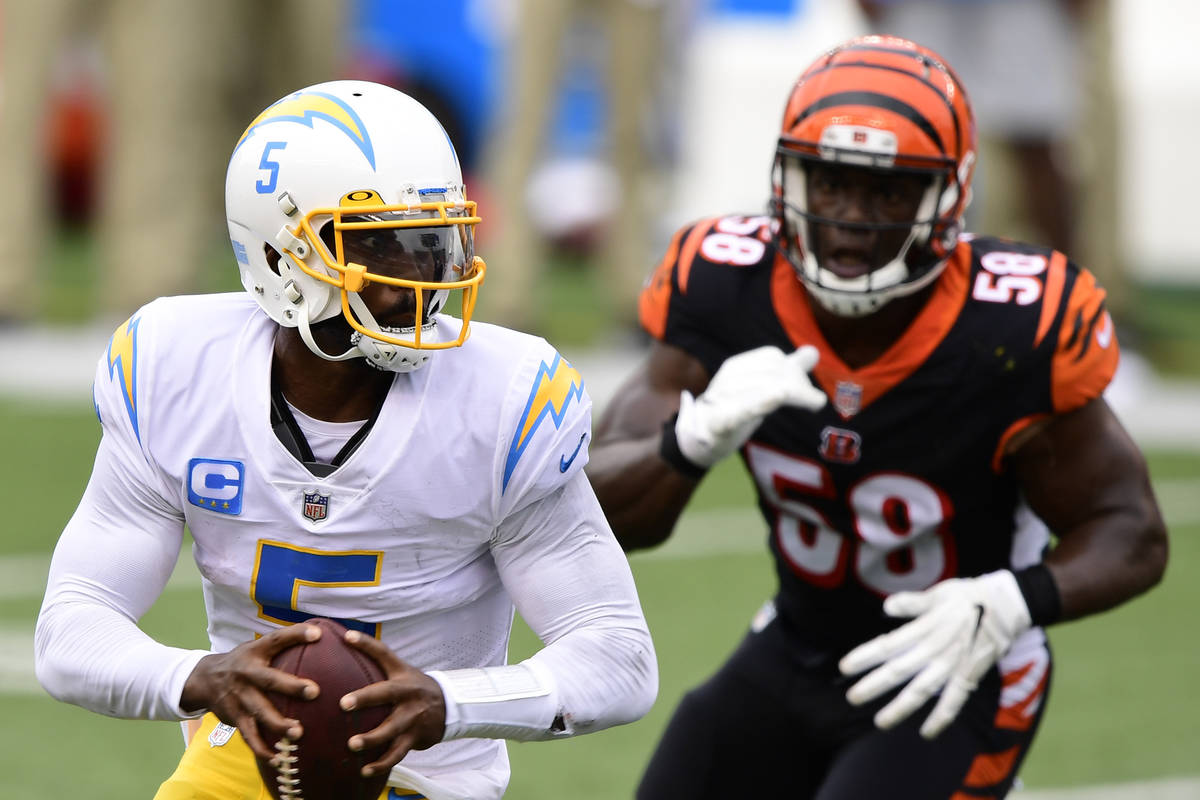Doctor explains Trent Brown, Tyrod Taylor needle mishaps

The Chargers will host the Raiders Sunday in a fierce AFC West rivalry between teams that recently have relocated and are enjoying new stadiums.
It also will be a matchup of teams that have gone through the most bizarre medical incidents of the 2020 season.
Raiders offensive tackle Trent Brown was wheeled out of the locker room in Cleveland last week and taken to the hospital with what has been described as a mishap with an intravenous injection.
The Chargers lost their starting quarterback Tyrod Taylor when his lung was punctured by a team doctor who was administering a painkilling shot to enable Taylor to play through cracked ribs suffered in an opening-week victory. Los Angeles is 1-5 since losing Taylor.
According to orthopaedic and sports medicine physician Caleb Pinegar of Las Vegas, the situation involving Brown is far rarer.
Reports indicate air entered his bloodstream during the application of the IV and potentially put him at risk of suffering an embolism.
The exact frequency of such a routine procedure going wrong is difficult to nail down because not all cases are reported as the effects can be relatively minor at times. Pinegar said his preliminary research indicated anywhere from .003 percent to .1 percent rate of occurrence.
Among the things that could go wrong are the bag of solution being hung too low or the tubing may not have the air fully bled out before it’s hooked up.
“As the IV gets administered, if it pushes this little section of air into the vessel, now you have air trapped inside the body,” he said. “The problem with that is if it gets to an area where it actually blocks blood flow beyond that spot, it can cause problems.”
Pinegar added the body will almost always correct the issue, but the stay in the hospital is to make sure the air pocket stays away from important structures in the body.
“Let’s say that gets introduced to the arm, as it gets back to the main vessels toward the heart, it can cause a person to feel short of breath, pained breathing, labored breathing,” he said. “It’s usually that anxiety and panic that freaks everybody out. … The likelihood is he was having shortness of breath, pained breathing and just got very, very nervous.”
Taylor’s situation is quite different. The kind of pain injection he was given shortly before kickoff against the Chiefs in September happens more often. The doctor suggested that’s why it’s not a very common practice, particularly outside of sports.
When the injection is given, the goal is to numb the area enough so a player can compete through the injury.
“You’re not going to cure the (cracked) rib, but you’re trying to make it so he can be functional,” said Pinegar, who indicated there can be problems in up to 6 percent of such injections.” That space where the nerves are beneath the ribs is really, really tight. You’re talking a couple millimeters. To numb the area, you have to get the needle deep enough without going too deep.”
When the needle punctures the lung, the air escapes as breath is drawn and at that point, the lung collapses.
The treatment can include surgically decompressing the lung or putting in a tube to drain out the excess air. Athletic competition, particularly in such a demanding contact situation as NFL football, would not be advisable until the lung is fully healed, which typically takes six to eight weeks.
Pinegar said the traditional way to administer a shot like the one given to Taylor would be to use anatomic landmarks like the bottom of a rib to find the exact spot. Many doctors still use this method because that’s how they were trained, but it is possible to use ultrasound to get a more precise look at the location of the needle.
“You can feel the rib and put the injection right there,” Pinegar said. “A lot of guys do use ultrasound, but it’s how you were trained and what you got used to. It’s done blind a fair amount of time. But as people get trained and are more used to the ultrasound devices, that’s being done a lot more.”
The mistake proved costly to Taylor. He will miss his seventh game on Sunday and may not regain his job because rookie Justin Herbert has performed admirably in the veteran’s absence in most categories except the win-loss column.
Brown, according to Pinegar, shouldn’t be forced to miss any game action because of his incident. “He shouldn’t have any complications at all,” the doctor said.
Brown may have been on track to return Sunday, but was placed back on the reserve/COVID-19 list on Thursday. Taylor is expected to be active and serve as the backup quarterback on Sunday for the first time since he was hospitalized on Sept. 20.
Contact Adam Hill at ahill@reviewjournal.com. Follow @AdamHillLVRJ on Twitter.